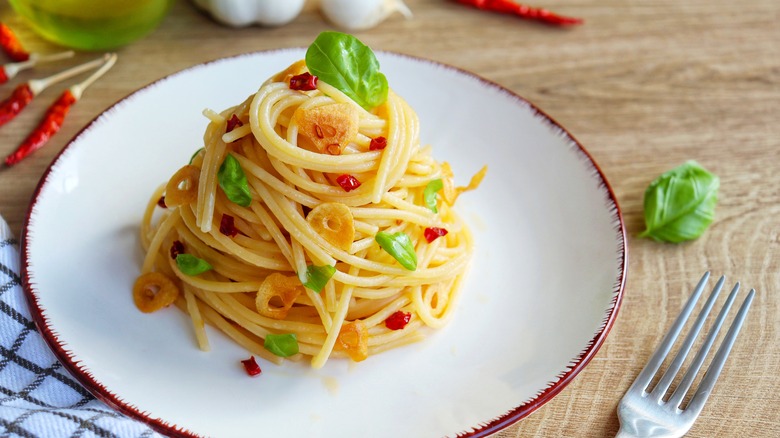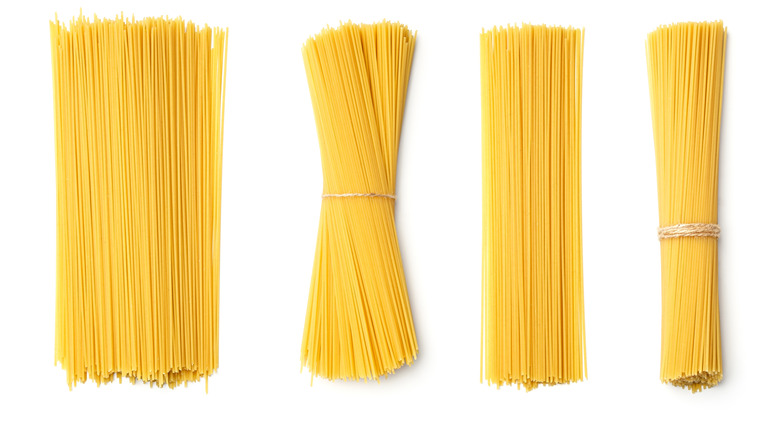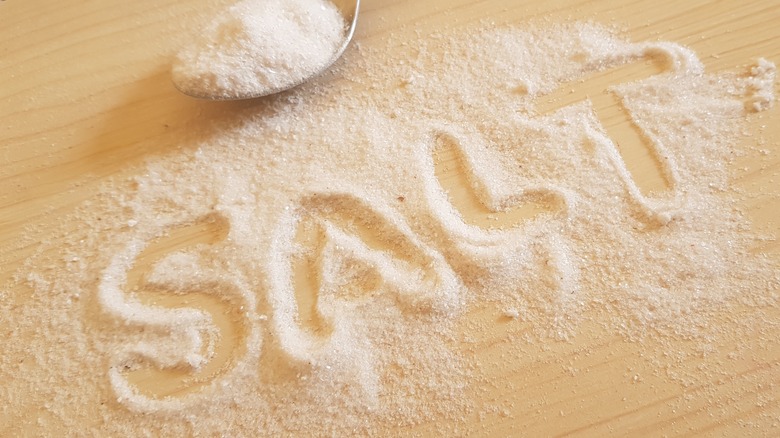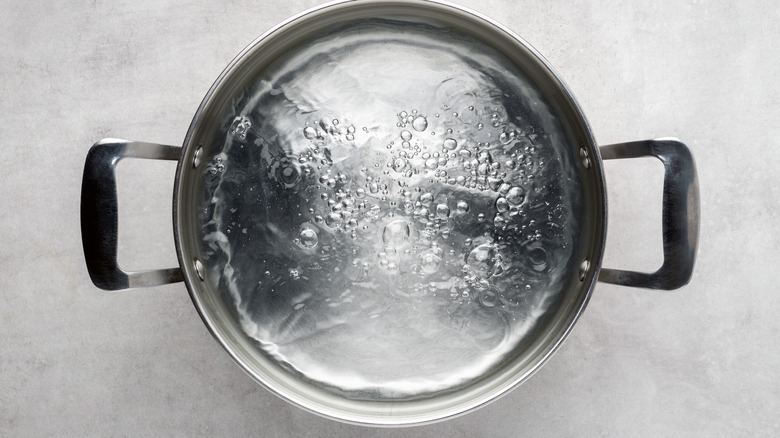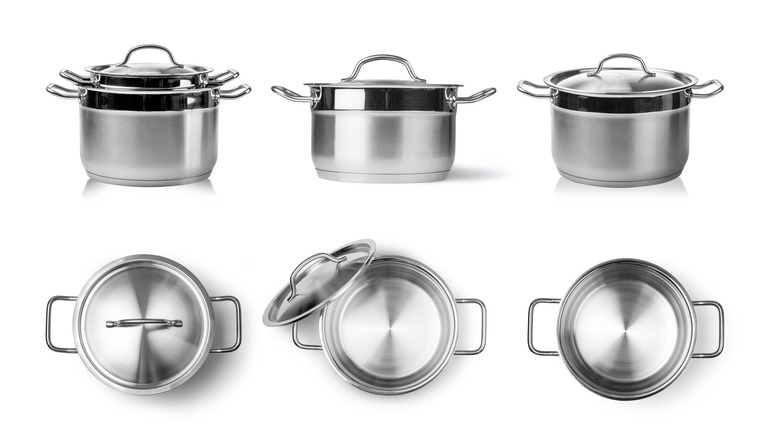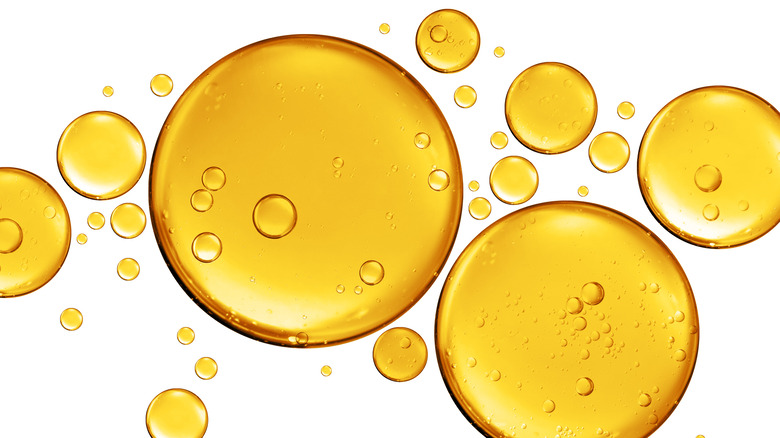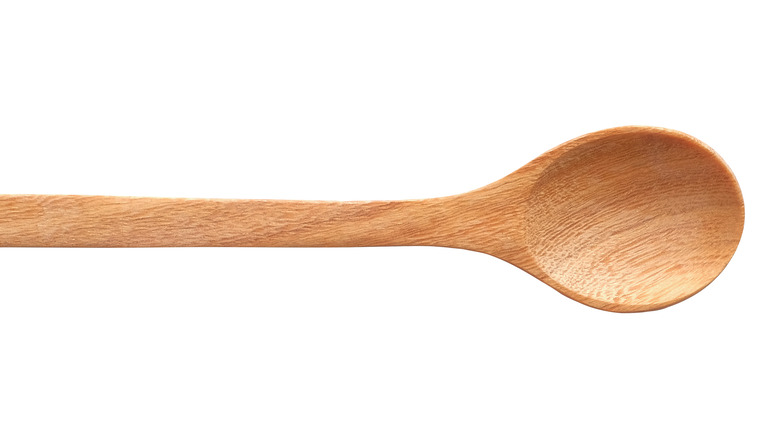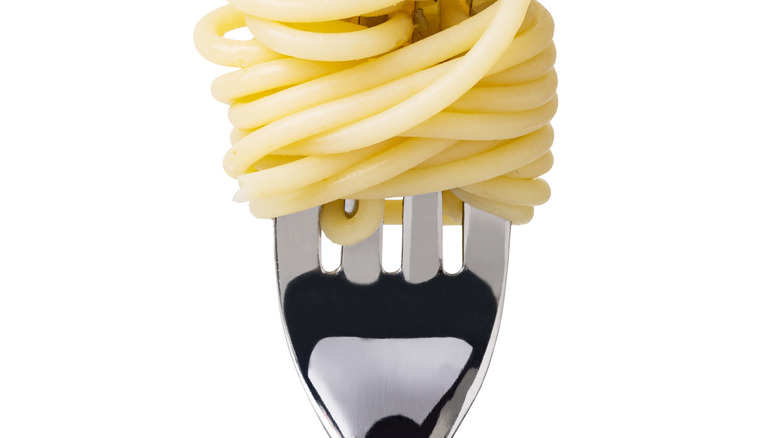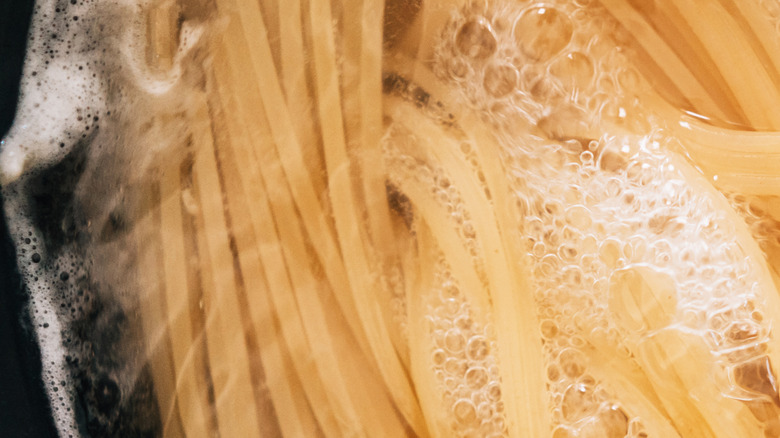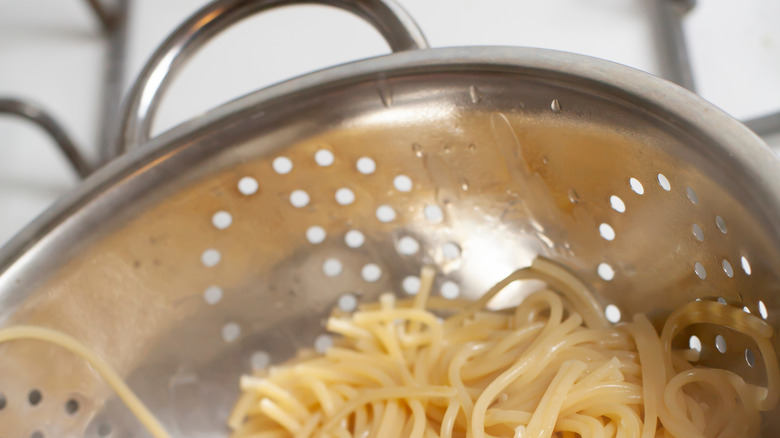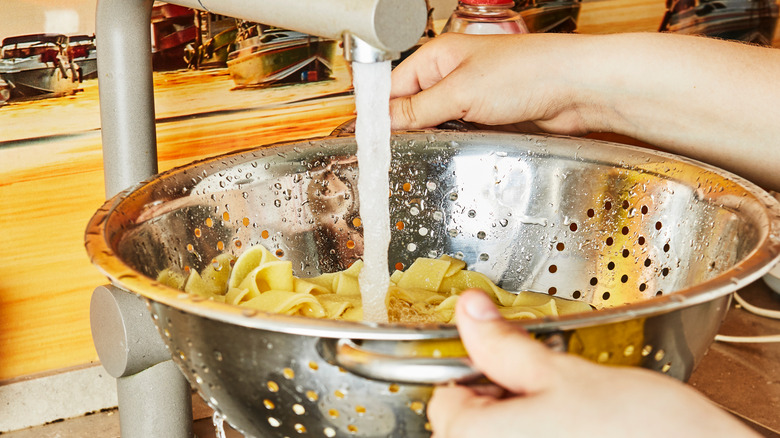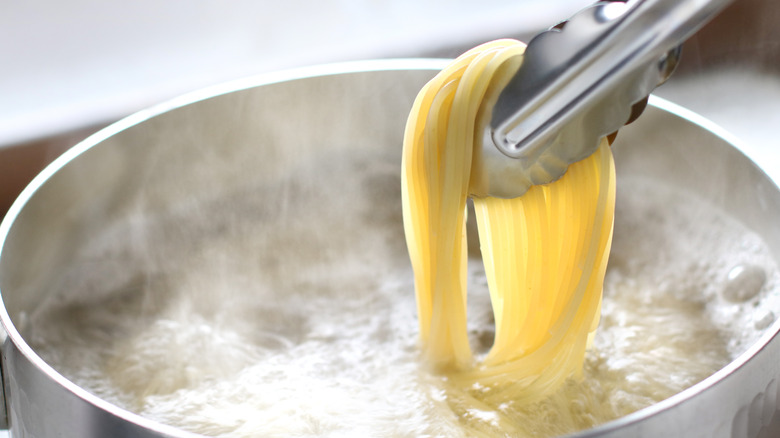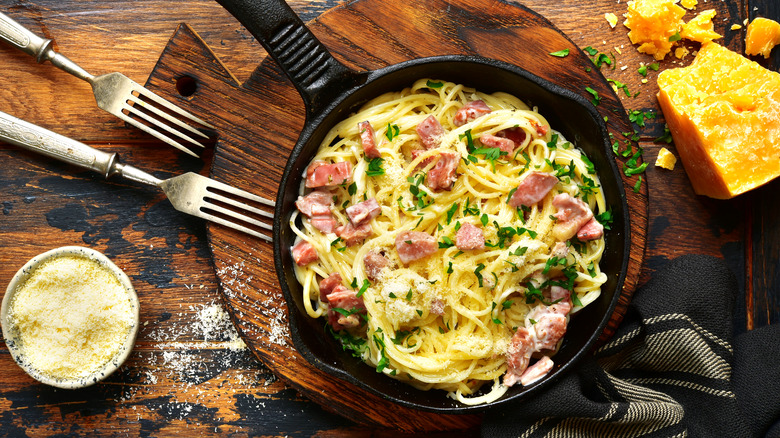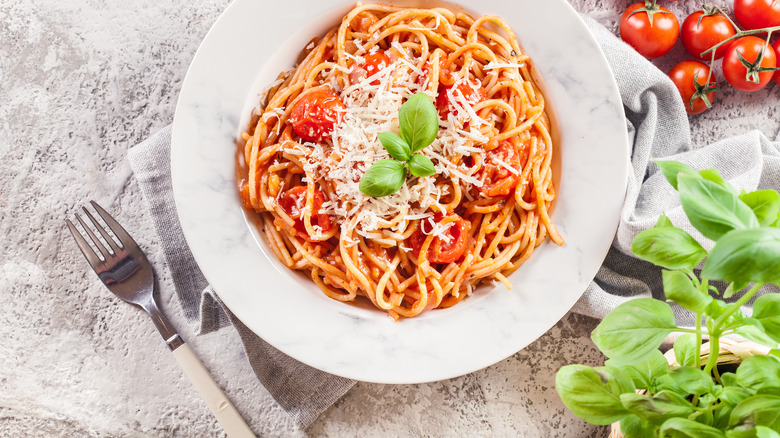14 Mistakes Everyone Makes With Spaghetti
Spaghetti is a beloved staple of traditional Italian cuisine. While many people believe Marco Polo introduced pasta to Europe during his tour of the Far East in the late 13th century, the Spaghetti Museum in Pontedassio, Imperia, Italy, showcases several documents from 1279 and 1284, well before Polo's return in 1292, which refer to pasta, maccheroni, and vermicelli (a thinner version of spaghetti).
Whatever its origin, spaghetti has become an emblem of Italian cuisine, typically cooked al dente (Italian for "to the tooth") and served with classic tomato sauce. It's also served with garlic and oil (spaghetti aglio e olio); with eggs, pork, and salty cheese (spaghetti alla carbonara); with clams (spaghetti alle vongole); and meatballs, for the signature Italian-American pasta dish, spaghetti and meatballs. Whether you're cooking spaghettoni, a thicker spaghetti, spaghettini, a thinner form, capellini, super-thin, 'angel hair' spaghetti, or standard spaghetti, here are common mistakes you'll want to avoid.
Buying a bargain basement spaghetti brand
Chef Francine Segan recommends starting with a quality dry spaghetti brand. "Buying a bargain basement brand is one of the worst mistakes you can make when making spaghetti. Bargain brand pasta ends up tasting like you boiled the box along with the pasta!" The best quality dry spaghetti will cook evenly thanks to uniform thickness and will not have a starchy film on its surface upon draining, thanks to better quality flour.
The fewer ingredients in the pasta, the better. The best brands are made with semolina flour, a higher quality, high-gluten flour made from hard durum wheat. Semolina flour is yellow and is high in gluten protein. Look for dry spaghetti that is pale yellow in color and a bronze die-cut, two clues that it's a quality brand of spaghetti. Check the box to ensure the spaghetti hasn't expired, and remember to store spaghetti in an airtight container in a dry cupboard to ensure freshness.
Not salting the water
Your pasta water needs way more salt than you think, so never skip the salt. Salt is the universal flavor enhancer, and spaghetti will absorb the salt from the water, enhancing flavor from the inside out. While you never want to oversalt your pasta water, adding the correct amount of salt is one of the most critical steps in the spaghetti-making process. Too little salt will lead to bland spaghetti no matter what kind of sauce is added.
So, how much salt is the right amount to reach perfectly seasoned spaghetti? The bottom line is that it comes down to preference. That said, 1 ½ teaspoon of table salt per liter of water is recommended. Experiment with the recommended amount, adding more or less salt until you reach the perfectly salted spaghetti that fits your tastes. Add more salt if you prefer a saltier flavor; less salt if you're looking to reduce sodium in your diet.
Not putting enough water in the pot
Adding the right amount of water to your pot is key to preventing your spaghetti from overcrowding or clumping up in the pot. A generous amount of water at a rolling boil in a roomy pot also returns to a boil faster after you add your spaghetti, which causes the temperature to drop. A big pot filled with the correct amount of water also makes it easier to submerge long spaghetti noodles.
So how much water should you use to cook spaghetti? The average chef-recommended water ratio to pasta is 4 quarts of boiling water for each pound of pasta. However, some chefs, like celebrity chef and Italian cooking expert Lidia Bastianich, recommend 6 quarts of water per pound of pasta. Make sure to fill your pot with between 4–6 quarts of water as a rule of thumb to ensure your spaghetti has enough space so the noodles won't clump together and your water returns to a boil faster, ensuring even cooking.
Not using a big enough pot to boil the pasta
Pot size matters when it comes to boiling spaghetti. If you add raw spaghetti to a too-small pot, the uncooked pasta will lower the water temperature too quickly, making it difficult to reach al dente perfection. If the noodles don't have enough space to circulate in the boiling water, your cooked spaghetti will result in a starchier and gummier bite since the starch that's supposed to boil off the noodles sticks around instead of dissolving.
Choose a 6 to an 8-quart-sized pot and fill it three-quarters of the way with the recommended 4 to 6 quarts of cold water per pound of spaghetti. If you live with spaghetti aficionados, opt for an even larger pot: 8- or 12-quart pots are the best option for cooking up larger servings of spaghetti and double as stockpots. Note that if you have an electric or induction cooktop, you'll need to use a specialized pot with a flat bottom.
Adding oil to the water
Just say no to the age-old myth that you must add olive oil to the pot of water before adding your spaghetti noodles. Adding olive oil to your pasta water to prevent the spaghetti from sticking together is simply unnecessary. The key to avoiding gummy noodles that clump together is to ensure your spaghetti is cooked in a big pot of water at a rolling boil. Adding oil to the water is simply a waste of precious oil and energy. Worse, when you drain your spaghetti, the layer of oil in the pot sticks to the noodles, making it more difficult for the sauce to stick to the spaghetti. In other words, the pasta sauce will slip right off the spaghetti. Skip the oil and ensure your spaghetti is cooked in a big pot filled with the correct amount of water at a roaring boil.
Adding spaghetti before the water reaches a rolling boil
One of the essential tips for any cook is to never add spaghetti to water that has not quite reached a rolling boil. Spaghetti must be cooked in water at a rolling boil for the noodles to reach al dente perfection, and a rolling boil also prevents the noodles from clumping together.
What's the difference between a simmer and a rolling boil? A rolling boil is an aggressive boil, with active bubbles causing the water to 'roll' so much that the pasta dances around the pot. You can hear a rolling boil as the bubbles fight their way to the surface. When you add spaghetti (or any pasta) to boiling water, the temperature will drop slightly, so it's important that the water is in an active state of boiling: the heat and active, rolling bubbles will prevent clumping and ensure that the noodles are all cooked consistently.
Not stirring spaghetti to keep it from sticking
Stir the pot! The Italian food experts at DeLallo advise stirring your pot within the first two minutes of cooking pasta. Dried spaghetti can sometimes stick to the bottom of the pot. Also, spaghetti noodles are more likely to clump together at the beginning of the cooking process, before the starches are released into the water. Give the spaghetti a swirl after adding it to the pot to prevent the noodles from clinging to the bottom, and another stir or two within the first two minutes of boiling prevents the noodles from clumping together. Once the water returns to a rolling boil, the bubbles keep the water in motion, and the spaghetti noodles separate, so they will cook evenly and not clump. A long wooden spoon is the best tool for stirring the pot as it's naturally antimicrobial, easy to clean, and dishwasher safe.
Not testing the pasta two minutes before the suggested cook time
Spaghetti tastes best when it's cooked to al dente perfection, which means the noodles are tender yet still have a somewhat firm texture. The starch at the very center of the noodles cooked al dente is only partially hydrated, so the noodles retain a slightly firm bite. To ensure that your spaghetti is perfectly al dente, test a noodle or two about two minutes before the recommended cook time. As you bite into the noodle, you should see a touch of white at the center of the noodle, and it should be somewhat firm (but not crunchy).
Some people maintain that throwing a spaghetti noodle against a wall is a good way to test for al dente perfection: if it sticks, legend states, the spaghetti is perfectly al dente. However, this technique is a myth, as even an overcooked, mushy spaghetti noodle can stick to a wall. Instead, test a noodle by biting into it a couple of minutes before the recommended cooking time.
Overcooking spaghetti
Soggy, mushy spaghetti noodles are among an Italian chef's worst nightmares. Spaghetti should be cooked through yet still firm. Avoid overcooking spaghetti by having a timer ready to go as soon as you place the noodles in the pot. Follow the recommended cooking time usually found on your spaghetti box: Generally, most brands of spaghetti cook in 8 to 10 minutes, but look on the package for an exact, recommended cooking time. Test a noodle or two for al dente perfection two minutes before the recommended cooking time is up.
Spaghetti should be the last thing you cook when preparing your meal since it cooks in mere minutes. Overcooked spaghetti not only tastes bad but is also less nutritious: According to Livestrong.com, when pasta is overcooked, the bonds between the molecules are damaged, which causes nutrient loss, too. Overcooked spaghetti will lose vitamins B-1 and B-5, as well as amino acids.
Not draining spaghetti properly
A recent viral social media post showcases a newfangled pasta cooking 'hack': The video shows a colander being placed over a boiling pot of pasta, which is then tipped over a sink to drain the cooking water. While this is one way of draining spaghetti, it's also risky and unnecessarily complicated. Ditch the colander and instead scoop the spaghetti directly from the pot into the sauce using tongs. This technique inevitably introduces a bit of starchy pasta water into your sauce, a step that will improve the texture and flavor.
You can also place a large colander in your sink, grab the pot with potholders and dump the spaghetti noodles into the colander, making sure to save a bit of pasta water to add to the sauce. Yet another option is a spider strainer: Italian Chef Lida Bastianich swears by a spider strainer, a small basket made out of chicken wire set at the end of a bamboo handle when it comes to draining pasta.
Rinsing spaghetti after draining
Italian chefs in the know would never, ever rinse spaghetti with cold water after cooking. Rinsing spaghetti after draining it is not only unnecessary, but it can also make it less flavorful. The excess starch that clings to the noodles after they're drained properly provides structure and flavor. Not rinsing your noodles retains some of the starch that cooks out into the water, making it easier for spaghetti to hold onto the sauce you plan to serve, leading to more flavorful spaghetti.
The only time you need to rinse your spaghetti is if you plan on eating it cold or at room temperature. You'll want to rinse spaghetti if you plan on using it in a pasta salad since rinsing stops the cooking process, bringing the noodles to serving temperature while also preventing the noodles from clumping up. This step allows you to mix in other cold ingredients like salad dressing.
Not saving the pasta water
Pasta water is an unexpected gem of an ingredient that some home chefs mistakenly pour down the drain. Always save at least a half cup of pasta water to add to your sauce. Pasta water is cloudy because of lingering starches and salts imparted from the pasta during the cooking process. These same starches and salts help thicken the sauce and bind it to the spaghetti.
This technique leads to emulsification, the Italian chef's secret to silky smooth sauces. Iconic Italian spaghetti dishes, like spaghetti carbonara and spaghetti cacio e pepe, rely on the starchy power of reserved pasta water to make a fine dining-level sauce.
There are other uses for leftover pasta water: Use it to up your pizza dough game or even water your plants. According to British chef Nigella Lawson, pasta water's starches can help home-baked bread rise, so use the cloudy pasta water in place of plain water the next time you're prepping pizza dough, or let it cool and use it to water your plants.
Not cooking the pasta with the sauce for at least two minutes
"The single most important technique for making perfect spaghetti is to finish cooking it in the sauce," recommends Chef Francine Segan. "Italians call it saltare in padella, 'jumping in the pan,' an essential cooking technique that allows the sauce to thicken and wonderfully mingle the flavors." Aim to cook the spaghetti with your sauce of choice for at least two minutes in a saucier over medium to high heat to marry the flavors, as the spaghetti noodles will better absorb the sauce and will be coated in the sauce much more evenly. We recommend finishing pasta in its sauce by heating your sauce in a large saucier with sloped sides, adding a bit of pasta water to aid in the emulsification process, and finally, adding the drained pasta. This process is recommended for both homemade and store-bought sauces.
Throwing away leftover spaghetti
Finally, save any leftover spaghetti! Cooked pasta is good for three to five days in the fridge, and you can even freeze your cooked pasta, which will keep it fresh for up to two months.
We recommend two key methods for reheating pasta to retain its texture. First, place it in a heat-safe colander and cautiously submerge it into boiling water for approximately 30 seconds to one minute; or sauté it in your choice of cooking oil over medium-high heat. Then, add your choice of sauce and simmer until the flavors are melded, usually about two to five minutes.
You can also use leftover spaghetti to make an altogether different dish, like spaghetti pie, a hearty pie that calls for sautéed broccoli and spicy Italian sausage, more than a pound of cheese, and of course, spaghetti. Finally, there's spaghetti pizza, a delectable 'pizza' that calls for cooked spaghetti in place of traditional pizza dough.
